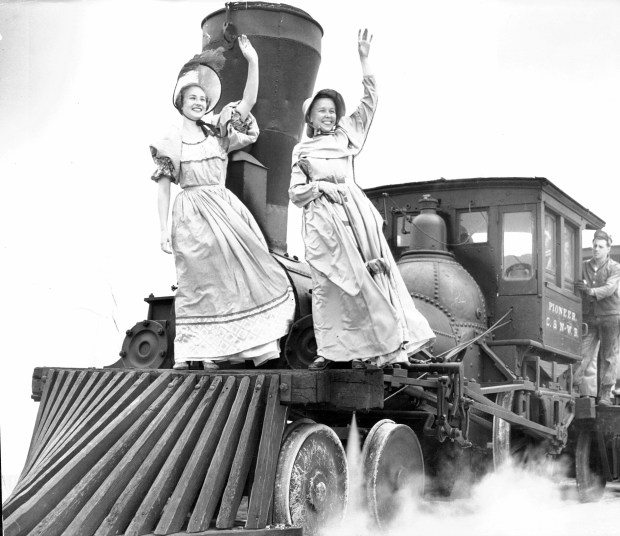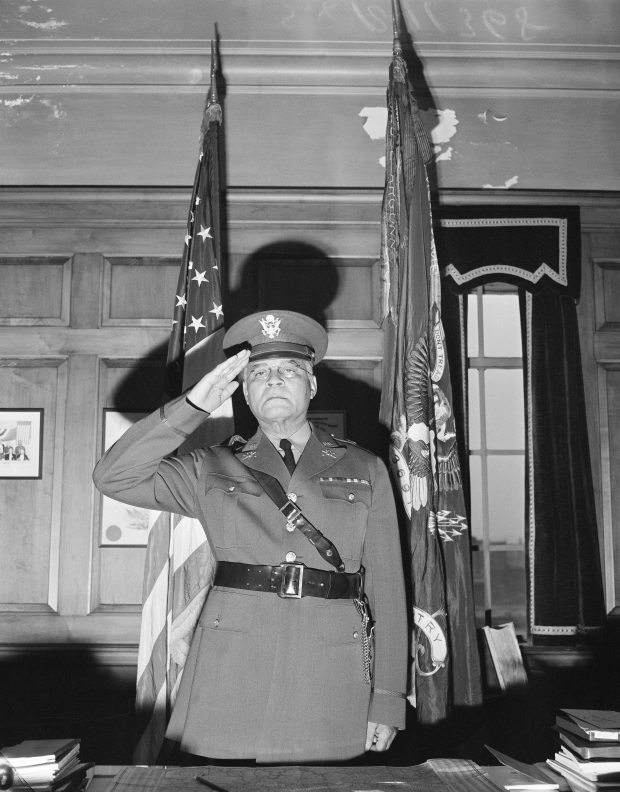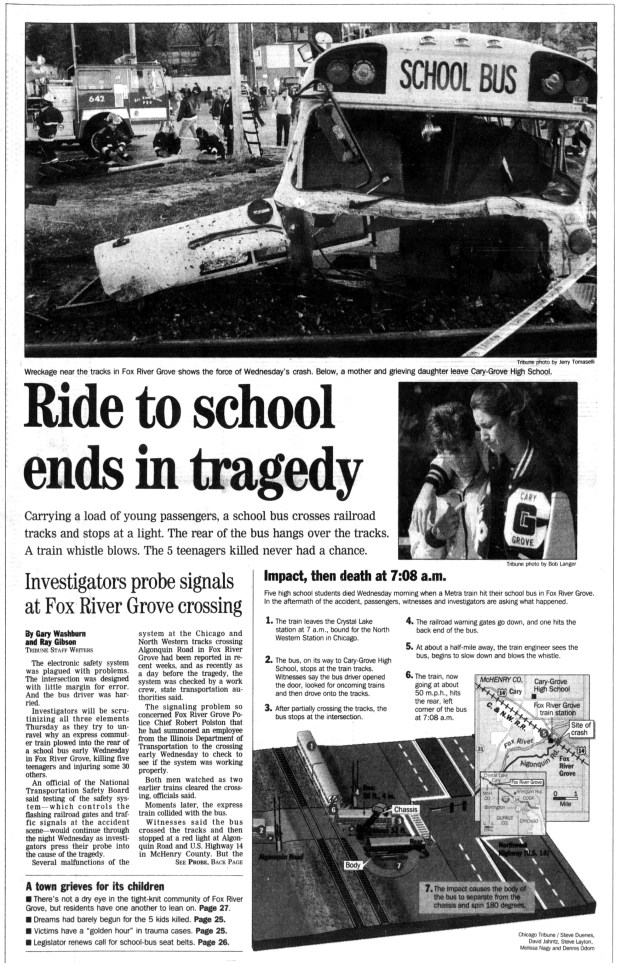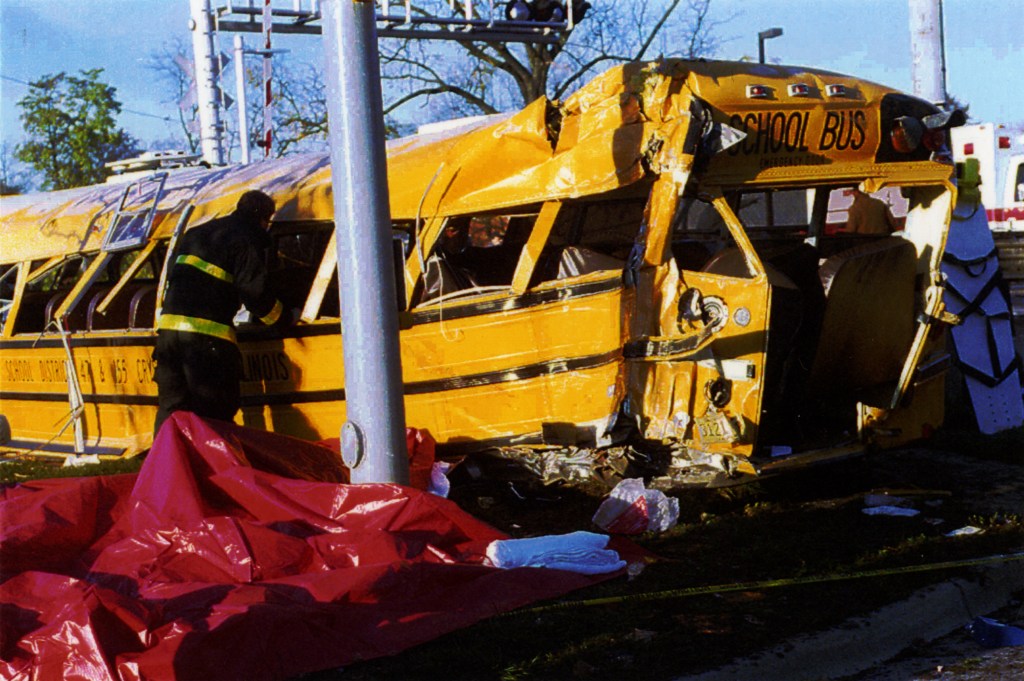Here’s a look back at what happened in the Chicago area on Oct. 25, according to the Tribune’s archives.
Is an important event missing from this date? Email us.
Weather records (from the National Weather Service, Chicago)
- High temperature: 79 degrees (1963)
- Low temperature: 14 degrees (1887)
- Precipitation: 1.94 inches (1883)
- Snowfall: 0.3 inches (1962)
 Norma Danielson, left, and Herta Reilly, in pre-Civil War costumes, get a ride on the Pioneer, a century-old locomotive, as it rolled under its own power during a preview of the Chicago Railroad Fair on July 14, 1948. (Chicago Tribune historical photo)
Norma Danielson, left, and Herta Reilly, in pre-Civil War costumes, get a ride on the Pioneer, a century-old locomotive, as it rolled under its own power during a preview of the Chicago Railroad Fair on July 14, 1948. (Chicago Tribune historical photo)
1848: Pioneer became the first locomotive to operate in Chicago. It pulled a train on its inaugural run from a railway station near Canal and Kinzie streets on the Galena and Union Railroad that stretched as far as Des Plaines.
1910: The Chicago Vice Commission was created to take up “the big problem of raising the moral conditions of the city,” the Tribune reported.
 Col. Benjamin Davis Sr. behind his desk in his New York office on Oct. 25, 1940. Davis became the first Black general in U.S. Army history with his promotion by President Franklin D. Roosevelt to the rank of brigadier general. (Preston Stroup/AP)
Col. Benjamin Davis Sr. behind his desk in his New York office on Oct. 25, 1940. Davis became the first Black general in U.S. Army history with his promotion by President Franklin D. Roosevelt to the rank of brigadier general. (Preston Stroup/AP)
1940: Col. Benjamin O. Davis Sr., a native of North Chicago, became the first Black general in any branch of the U.S. military when he was promoted by President Franklin D. Roosevelt to brigadier general of the Army.
In 1942, Davis joined then-Lt. Gen. Dwight D. Eisenhower in Britain as an adviser on race. Eisenhower later accepted Davis’ recommendation that racially integrated platoons be created in the European theater.
“Most of the remaining racial barriers were dropped in 1948, the year Davis retired from the Army,” the Tribune reported when Davis died in 1970 at age 93.
Davis’ son — Benjamin O. Davis Jr. —was a pioneering military officer who was the leader of the fabled Tuskegee Airmen during World War II and the first African American to become a general in the Air Force.
Both men are buried at Arlington National Cemetery.
1978: “Halloween” — set in the fictional Haddonfield, Illinois, and starring Donald Pleasence and Jamie Lee Curtis — premiered.
Tribune’s famed movie critic Gene Siskel loved it after he seeing it at the Chicago International Film Festival. He called it “one of the scariest films I have ever seen” and ranked it eighth on his list of favorite motion pictures for 1978. The Library of Congress inducted “Halloween” into the National Film Registry in 2006 for its technical innovations including the extensive use of Panaglide from the almost silent, staring, slow-moving killer’s — originally known as “The Shape” — perspective.
 Texas Rangers pitcher Ferguson Jenkins pitches to Oakland A’s outfielder Joe Rudi in the ninth inning of a game in Oakland, California, on Sept. 8, 1974, as he won his 22nd game of the season against 11 losses. (AP)
Texas Rangers pitcher Ferguson Jenkins pitches to Oakland A’s outfielder Joe Rudi in the ninth inning of a game in Oakland, California, on Sept. 8, 1974, as he won his 22nd game of the season against 11 losses. (AP)
1973: “I called Mr. Holland right after our last game Monday and told him that a change of uniforms would probably do me a lot of good,” Chicago Cubs pitcher Ferguson “Fergie” Jenkins told reporters in early October.
The future Hall of Famer got his wish — he was traded to the Texas Rangers in exchange for third baseman Bill Madlock and utility player Vic Harris.
Jenkins had a career-high 25 wins during the 1974 season with the Rangers.
 Seven Cary-Grove High School students were killed Oct. 25, 1995, when the school bus in which they were riding was struck by a Metra commuter train on tracks crossing Algonquin Road in Fox River Grove. (Chicago Tribune)
Seven Cary-Grove High School students were killed Oct. 25, 1995, when the school bus in which they were riding was struck by a Metra commuter train on tracks crossing Algonquin Road in Fox River Grove. (Chicago Tribune)
1995: A bus loaded with high school students was hit by an express commuter train at a crossing in Fox River Grove, tearing the bus body from the chassis and killing seven aboard the bus. No one on the train was injured.
The bus had been stopped by a red traffic signal at U.S. Highway 14 (Northwest Highway) immediately after crossing the Union Pacific Railroad tracks. The rear of the vehicle hung out over the tracks and was hit by the morning commuter train, which was traveling at a high speed. A preliminary NTSB investigation indicated a flaw in the electronic components intended to override the highway traffic signals when a train approached.
Want more vintage Chicago?
Subscribe to the free Vintage Chicago Tribune newsletter, join our Chicagoland history Facebook group, stay current with Today in Chicago History and follow us on Instagram for more from Chicago’s past.
Have an idea for Vintage Chicago Tribune? Share it with Kori Rumore and Marianne Mather at krumore@chicagotribune.com and mmather@chicagotribune.com
